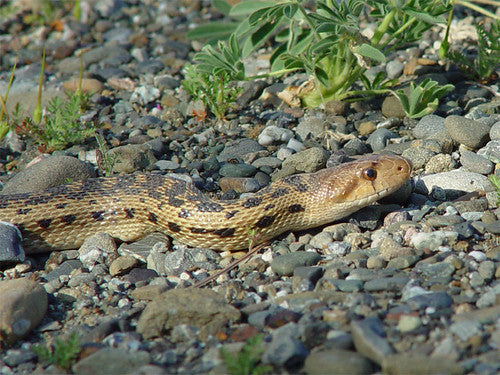Garter snakes (Thamnophis sp.) are small- to medium-sized, terrestrial, diurnal snakes widespread throughout North America and Central America. They can be found in a variety of habitats.
Depending on the species, garter snakes can be as small as 18” long or as large as 5’ long when full-grown. They have slender bodies, keeled scales, and large round eyes. They are not constrictors. Coloring and pattern varies widely from species to species — they can be camouflaged in earth tones or bright blue and red, with speckles, stripes, or no pattern at all.
Garter snakes are well-known in the US as a frequent occurrence in gardens and backyards. However, they can make hardy, beginner-level pet reptiles when purchased captive-bred. With good care, a CBB garter snake may live as long as 12 years.
Garter snakes’ care requirements are generally fairly similar from species to species, however there are essential differences that should be noted. This care sheet should be used only as a general guide, and we strongly recommend doing research on your specific species/subspecies of garter for best results.
Garter snakes are very common in the US, but that does not mean it’s a good idea to capture one from the wild if you want one as a pet. Wild-caught garters are often more stressed in captivity and often carry heavy parasite loads.
How much space do garter snakes need?
Because garter snakes are slender, many people think of them as smaller than they really are, keeping them in enclosures that are too small for them to stretch out fully, explore, and climb. Remember: this is an active snake that moves around a LOT in the wild!
The general rule for keeping most snakes is that the length and width of the enclosure should add up to as long or longer than the snake’s expected adult length. For example, if you have a garter snake that is likely to grow to 18” as an adult, then a 12” x 12” x 12” terrarium is an acceptable minimum. However, if you have a species of garter snake capable of growing up to 5’ long, then a 36” x 24” x 24” terrarium is going to be your minimum.
This is just the minimum, so using larger dimensions is strongly recommended!
Cohabitation (keeping multiple garter snakes in one enclosure) is optional for species that do not have cannibalistic tendencies. Some people argue that cohabitation is actually better for the snakes’ mental health than housing singly. However, do note that if you are housing multiple snakes in the same enclosure, the enclosure needs to be larger than it would be for just one animal.
Do garter snakes need UVB?
They can survive without it, but it’s still best practice to provide UVB lighting for optimal health and wellbeing. After all, garter snakes are primarily active during the day, so it’s likely they’re naturally exposed to sunlight on a regular basis. UVB gives garter snakes all of the vitamin D that their bodies need, stimulates better appetite and activity, and generally allows them to be healthier than they would be without.
The best UVB bulbs and distances for garter snakes are:
- Zoo Med T8 Reptisun 5.0 — 4-6” through mesh
- Arcadia ShadeDweller kit — 6-8” through mesh
- Zoo Med T5 HO Reptisun 5.0 — 9-11” through mesh, 12-14” without
- Arcadia T5 HO Forest 6% — 9-11” through mesh, 12-14” without
The UVB bulb should be housed in a reflective fixture (Arcadia or Vivarium Electronics brand) and placed close to the heat lamp. UVB is blocked by glass and plastic, so you can’t give your snake UVB by placing its terrarium in front of an open window. The bulb must be replaced every 12 months to maintain performance.
Lights should be on for 14 hours/day during summer and 10 hours/day during winter. This helps encourage more natural hormonal rhythms and better long-term health.
What basking temperatures do garter snakes need?
Like other reptiles, garter snakes are ectotherms, which means that they need a temperature gradient in their enclosure to help them regulate their metabolism and stay healthy.
Garter snakes should have a basking surface temperature of 90-95°F. On the other side of the enclosure, the temperature should be between 72-82°F. Use at least two digital probe thermometers to track your temperature gradient. Heating should be turned off at night.
Provide heat for your garter snake by imitating the sun with a halogen heat lamp placed on one side of the enclosure, positioned over a wide, flat piece of stone. For larger snakes, it’s a good idea to use two or more heat bulbs to provide more even heating. Do not use ceramic heat emitters (CHEs), red bulbs, or blue bulbs, as these are not as effective.
What humidity levels do garter snakes need?
Garter snakes’ humidity needs vary by species, but generally speaking, it’s best to keep ambient humidity between 30-60%. Use a digital probe hygrometer placed in the middle of the enclosure to keep tabs on this metric. There should also be a humid hide for your snake on the cool end of the enclosure, lined with moistened sphagnum moss. Always having a humid retreat available is essential!
Misting your snake’s enclosure with a sprayer as needed will help create the right humidity levels. If you need more, moisten the substrate by mixing water into it as needed.
What substrate is good for garter snakes?
Garter snakes require a thick layer of moisture-retentive substrate to cushion their bodies and help maintain healthy humidity levels. They also tend to like to burrow around in it. As an added perk, it also tends to make the enclosure more attractive.
Ideally, this substrate should resemble what garter snakes naturally live on in the wild: soil. It should have small particles and hold moisture well. We recommend the following substrates for garter snakes:
Layering clean, chemical-free leaf litter on top of the substrate can also help with humidity and provides a source of enrichment for the snake!
Substrate should be at least 3” deep and completely replaced every 3-4 months. Remove poop and urates daily, along with contaminated substrate.
What décor can you use in a garter snake terrarium?
It’s terribly boring for a snake to be stuck in an enclosure with nothing in it except substrate, hides, and a water bowl. It doesn’t matter how big the enclosure is if you don’t put things in it for your pet to use and interact with.
Aside from hiding places, you will also need at least one sturdy branch for your snake to climb on. Additional options include:
What do garter snakes eat?
Like other snakes, garter snakes are carnivores, which means that they need to eat whole animal prey in order to get the nutrition that they need. Contrary to popular belief, they are not insectivorous.
Feeding frequency varies depending on diet. A garter snake fed primarily on earthworms should be fed twice a week. If it takes mostly fish, then offer food every 5-6 days. Mouse eaters should be fed every 7 days. Juveniles should be fed more often than adults. Prey items should be around 10% of your snake’s weight and/or no more than 1.5x its width. Meals should be enough to create a bulge in the snake’s body, but it shouldn’t look ready to burst.
Garter snakes are particularly dependent on a varied diet. Here are some feeder options to consider:
- dew worms
- chopped nightcrawlers
- leeches
- slugs (captive-bred only)
- sand eels
- whole guppy
- whole molly fish
- whole platy fish
- fish filet (thiaminase-free)
- pinky mice
- quail eggs
- Reptilinks
- garter snake chow
To prevent accidental bites to your hand, prey should be offered via soft-tipped tweezers.
Supplements
It’s best practice to round out your garter snake’s diet by lightly dusting prey items with powdered calcium and multivitamin supplements. We recommend Repashy Calcium Plus LoD.
Water
Your garter snake should have access to clean, fresh water at all times. Provide a water bowl large enough for the snake to soak its entire body if desired. Change the water daily and scrub the bowl with a reptile-safe disinfectant weekly, or whenever it becomes soiled.
Do garter snakes like to be handled?
Few reptiles actually “like” to be held, and garter snakes can vary in their tolerance of handling. Some get used to it, while others prefer to be left alone. If your snake is open to handling, here are some rules:
- be gentle
- pick up the snake from below rather than from above
- support as much of its body as possible
- leave the head free to explore
- make handling a good experience
- NEVER pick up a snake by its tail!
*This care sheet contains only very basic information. Although it’s a good introduction, please do further research with high-quality sources to obtain additional information on caring for this species.
Image by Karsten Paulick from Pixabay




Leave a comment
This site is protected by hCaptcha and the hCaptcha Privacy Policy and Terms of Service apply.